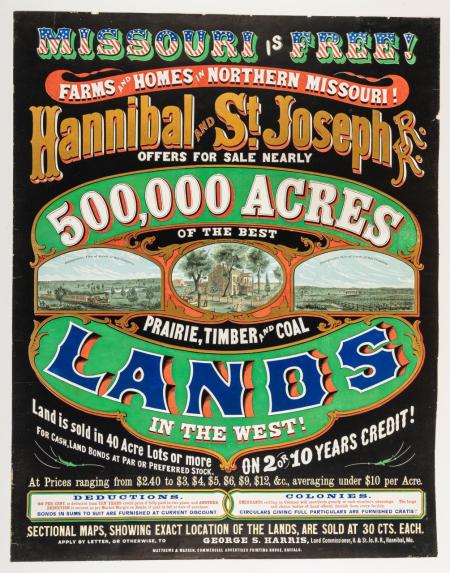
This chromolithographed broadside was used in the 1860s to promote land sales made by a railroad company in northern Missouri.
Worcester, MA (March 3, 2025) — The American Antiquarian Society (AAS), a national research library in Worcester, Massachusetts, has received an unprecedented gift of more than 18,000 pieces of eighteenth- and nineteenth-century ephemera. The collection, assembled over several decades by Stephen Davies Paine (1932-1997) and given to AAS in his memory, is one of the largest and most pristine of its kind. The materials include a wide variety of printed items used in daily life, such as flyers, prints, scrapbooks, broadsides, ticket stubs, shop receipts, and steamboat schedules. In addition, thousands of business trade cards and advertisements printed between 1780 and 1915 illustrate a range of pursuits, including agriculture, banking, insurance, mining, printing, and transportation―and span across the United States and abroad.
Meticulously organized and preserved, this exceptional new collection at AAS provides an important window into the history of American enterprise and the vast social, economic, and political changes that took place in the nineteenth century. The gift of Paine’s collection is among the largest the Society has had in its 213-year history. “Thanks to Stephen Paine’s discerning eye for quality and keen interest in history, this collection of ephemera is among the finest anywhere. Its scale and scope are game-changing for AAS. In these objects, and in their connections to the Society’s other collections, researchers now and for generations to come will find innumerable stories that deepen our understanding of the American past,” said Scott Casper, president of the American Antiquarian Society.
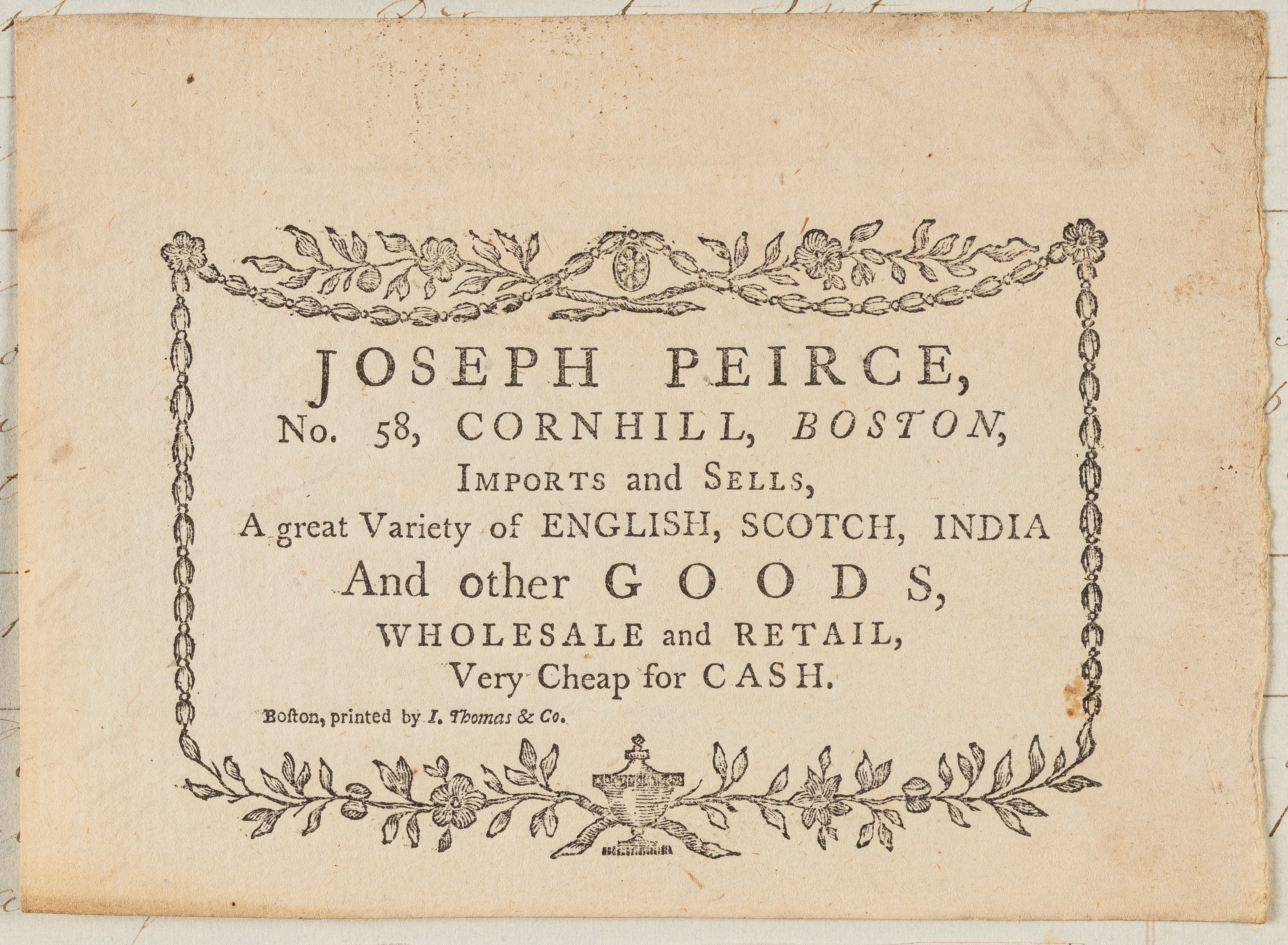
According to Lauren Hewes, vice president for collections, many of the materials in Paine’s collection―trade and business cards, broadsides, advertisements, tickets, and so on―were not meant to be saved. “They were made to be used for a short time and then discarded or recycled,” she said. “Yet these remnants of everyday life are some of the best resources we have for comprehending the past. We are fortunate that Stephen Paine understood this and undertook to collect and preserve them.” Paine’s collection includes many rare and exceptional examples of eighteenth- and nineteenth-century artifacts.
Among them are:
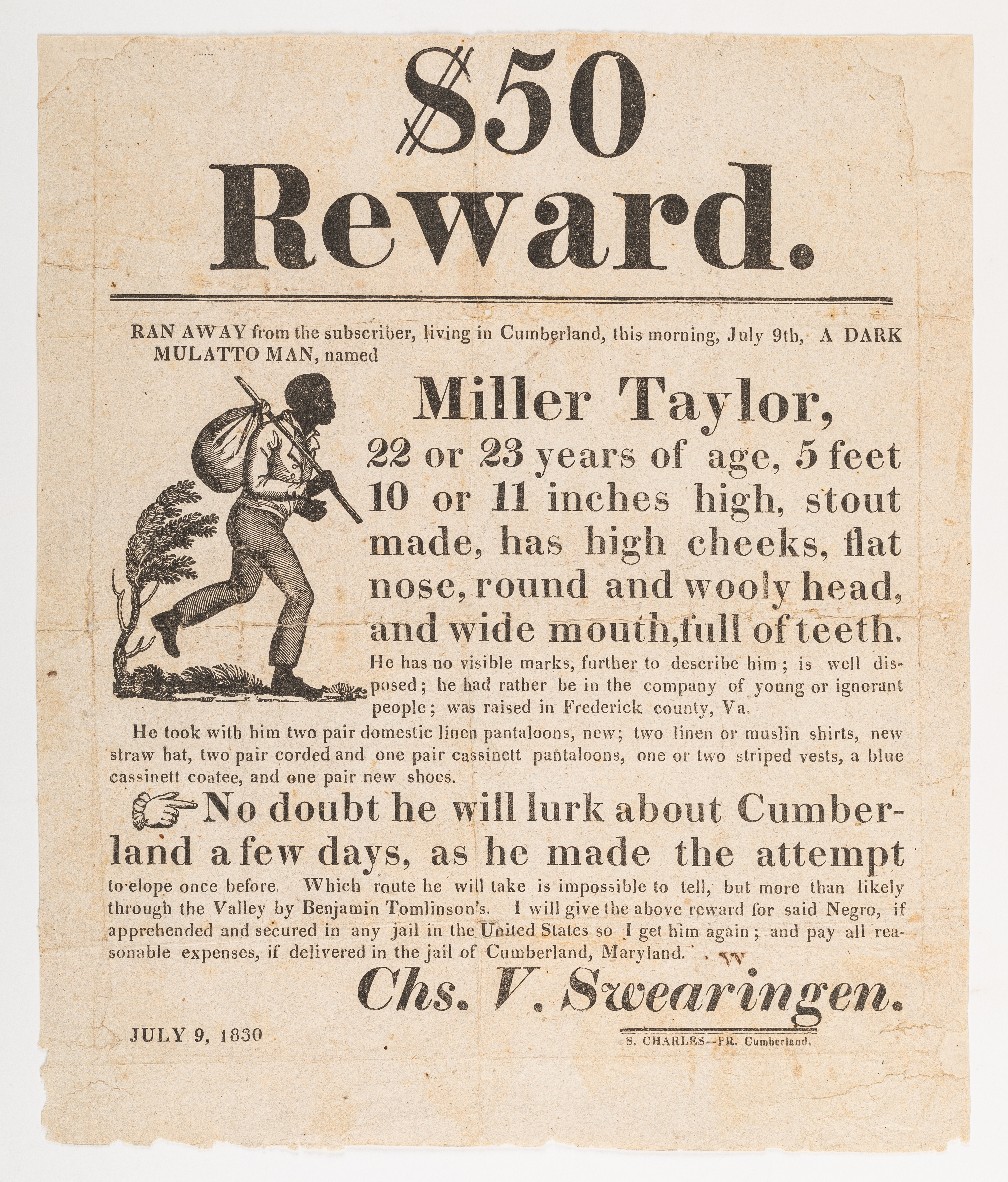
A letterpress broadside announcing a $50 reward for the capture of Miller Taylor who fled slavery in Cumberland, Maryland, in July 1830. A trade card for importer Joseph Peirce, printed by the newspaper publishers Isaiah Thomas & Co. in Boston around 1788 and used by Peirce to advertise his import business to customers and wholesale agents. Surviving eighteenth-century trade cards, which are rare, highlight the economic connections between merchants and printers in the early republic.
- A letterpress broadside announcing a $50 reward for the capture of Miller Taylor who fled slavery in Cumberland, Maryland, in July 1830. The advertisement includes a physical description of Taylor, including his age and height, and reveals that this was his second attempt to self-liberate. Fugitive slave announcements, which also appeared in newspapers, would have been posted around the city and surrounding towns. Posted bills were often pasted over, destroyed by weather, or pulled down by residents, making many surviving broadsides the only known copies. The texts bear witness to the individuals who defied the formidable legal structure of slavery.
- An eye-catching chromolithographed broadside, titled Missouri is Free!, used in the 1860s to promote land sales made by a railroad company in northern Missouri, part of the nation’s western expansion after the Civil War. Railroads sold land granted by the federal government to help fund construction of the rail network. This broadside offers forty-acre lots for $10 per acre by the Hannibal & St. Joseph Railroad. According to a company report, the bucolic images of wide-open prairies and elegant homesteads helped tempt more than 100,000 investors to purchase lots.
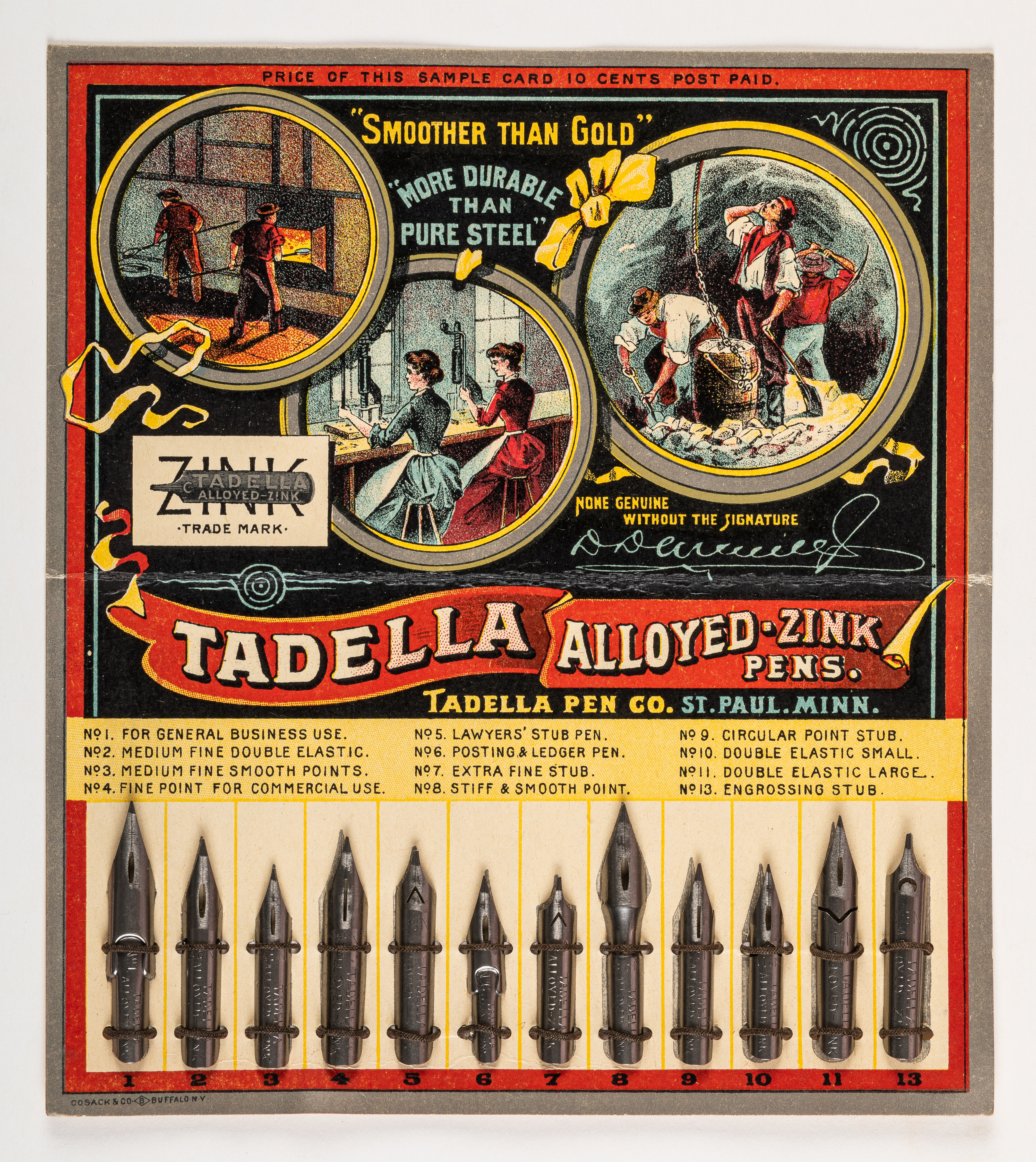
A chromolithographed 1889 sample card from Tadella Pen Company in St. Paul,
Minnesota, including twelve actual pen tips.A chromolithographed 1889 sample card from Tadella Pen Company in St. Paul, Minnesota, including twelve actual pen tips. Tadella Pens were the invention of D.D. Merrill, a stationer and bookseller in St. Paul who created an alloyed zinc pen tip in the 1860s. The business, with the motto “Smoother than Gold,” advertised its pens in magazines and newspapers across the United States. This sample card, with images of zinc mining, smelting, and female press workers, was intended for use by salesmen. The pen tips show the range of the firm’s offerings, from medium fine smooth points to circular point stubs. In an era before typewriters, penmanship was a vital business skill, and the right pen was an important tool for record keeping.
- A letterpress trade card from 1876, advertising Mrs. H. Shaw’s Los Angeles Nursery. Harriet Shaw promoted her business in California newspapers as early as 1872 and continued to sell fruit and nut trees for more than a decade. By 1875 she boasted an inventory of 100,000 trees including oranges, lemons, limes and walnuts. In 1879 she delivered baskets of fresh peaches and oranges to newspapers in Los Angeles as a publicity stunt and was rewarded with positive press. Documenting Shaw’s contributions to the agricultural expansion of California, this card reminds researchers of the role that women played in the U.S. economy.
A selection of high resolution images is available here
About Stephen Davies Paine
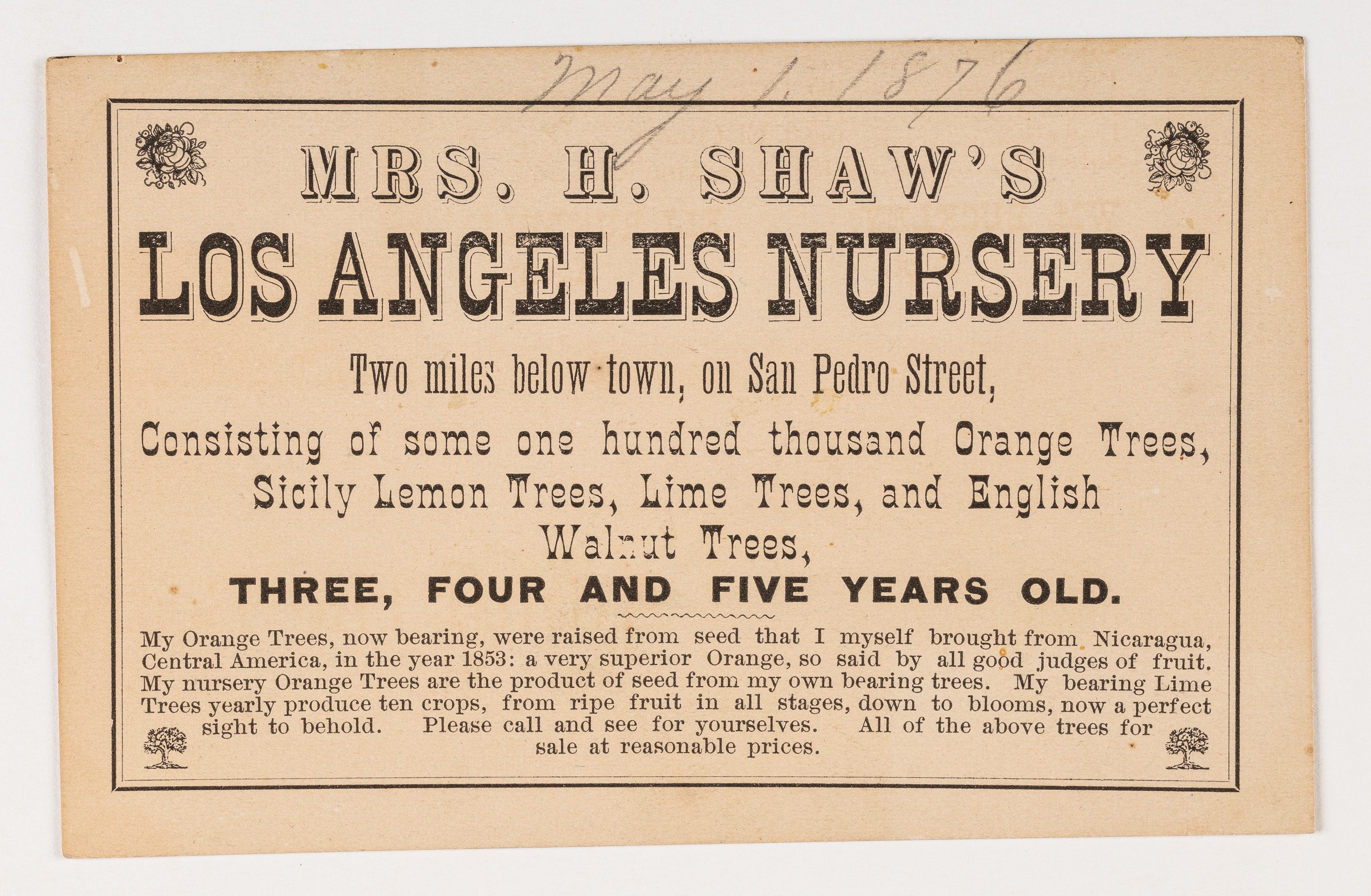
Stephen Davies Paine was raised in Brookline, Massachusetts, and attended Deerfield Academy and Williams College. Upon graduation from Williams in 1954, he entered the United States Air Force, and while in the service, contracted polio. During his long period of convalescence, he developed a deep interest in American contemporary art, which led to what would become his lifelong passion: collecting printed and engraved ephemera. Over the course of more than two decades, Paine sought out and purchased the best examples of elegant typography, impeccably engraved vignettes, and colorful lithography, assembling an unparalleled collection of ephemera.
He served on the boards of several cultural organizations, including the Institute for Contemporary Art and the Museum of Fine Arts in Boston, the Clark Art Institute and Williams College Museum of Art in Williamstown, and on the drawing committee at the Whitney Museum of American Art in New York. He served on the board of the Ephemera Society of America from 1982 to 1994 and was elected a member of the American Antiquarian Society in 1990.
The Stephen Davies Paine Collection of Ephemera at AAS shares Paine’s respect for the artists and designers involved in its creation, his recognition of their talent, his acknowledgment of the technology of the era, and his belief in the historical importance of this material to teach social history. The collection acknowledges also the joy and pleasure Paine received in working with other collectors in the field and the expertise of the booksellers and ephemera dealers who dealt in this material.